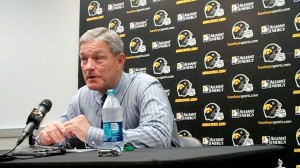9/24/2013: Iowa football notebook
Posted on 24. Sep, 2013 by admin in Iowa Football

Iowa head coach Kirk Ferentz discusses the Hawkeyes’ upcoming Big Ten opener at Minnesota during his weekly press conference held Tuesday, Sept. 24, 2013, at the Hayden Fry Football Complex in Iowa City.
By Brendan Stiles
HawkeyeDrive.com
IOWA CITY, Iowa — Take a walk inside the Hayden Fry Football Complex and there’s an atrium full of trophies. Most of these trophies are a result of Iowa bowl victories and conference titles.
Except for two.
One is the Cy-Hawk Trophy the Hawkeyes recently reclaimed after beating Iowa State back on Sept. 14 in Ames. The other is Floyd of Rosedale, a bronze pig that has spent the past year in the Hawkeye State after Iowa ended a two-game losing streak to Minnesota last season. That latter trophy is at stake yet again when the Hawkeyes travel to the Twin Cities to open up Big Ten play against a Golden Gopher squad that once again enters this border war with an unbeaten 4-0 record.
This time around though, it’s not a matter of Iowa taking something back as recent rivalry games have demonstrated, but rather keeping current possession of something.
“I’d hate to see Floyd go to someone else,” sophomore defensive end Drew Ott said. “I’m kind of fond of the pig.”
For the third time in four years, the Hawkeyes will be playing this rivalry contest in the unfriendly confines of TCF Bank Stadium. Unfriendly, because Iowa’s first two trips there in 2010 and 2011 both resulted in losses to what were inferior Minnesota teams at the time. The 2010 game saw the Golden Gophers jump out to an early 10-0 thanks to recovering a first-quarter onside kick and they ultimately prevailed 27-24. In 2011, Iowa held a 21-10 before surrendering 12 unanswered points in the fourth quarter to fall 22-21.
In order for the Hawkeyes to produce a different result there this weekend, they’ll have to do so against a version of the Golden Gophers that (at least on paper) is on even ground with them not just in the Big Ten, but in the Legends Division.
“Part of that is a credit to them, but part of the blame lies at our feet too,” Iowa head coach Kirk Ferentz said of those previous losses at TCF Bank Stadium. “If we play like we did the last two times, we’re not going to win the game. I’ll make that prediction right now.”
Battle of ground attacks
For all the points compiled by both Iowa and Minnesota so far this season, Saturday’s showdown has the makings of a physical, low-scoring tilt. That’s because these two teams share two major strengths in common — the ability to run the football offensively and the ability to stop the run defensively.
As far as the Golden Gophers are concerned, the running game is their identity, even with the likelihood of back-ups starting at both quarterback and running back on Saturday. Through four games, Minnesota has accumulated an average of 282 yards per game on the ground and nearly 73 percent of its 1,550 yards of total offense have been from running the ball. The Golden Gophers also lead the Big Ten with 16 of their 22 touchdowns coming via the run.
Mitch Leidner is expected to make his second career start at quarterback Saturday in place of injured signal-caller Philip Nelson, who’s currently dealing with a hamstring injury. In his debut, Leidner led Minnesota to a 43-24 win over San Jose State by rushing for a team-high 151 yards and four touchdowns on 24 carries. As a result, he was named the Big Ten’s Freshman of the Week.
“It’s a little different, but we’ve seen plenty of those type of quarterbacks who look to make plays with their feet,” senior free safety Tanner Miller said. “That’s not really something we’re foreign to, so it’ll be good. It’s just something that we have to prepare for this week.”
At running back, the Golden Gophers are looking at David Cobb — who currently leads the team in rushing — getting the bulk of the carries with Donnell Kirkwood still dealing with a knee injury. In that same contest last weekend against San Jose State, Cobb rushed for 125 yards on 25 carries and scored two touchdowns on the ground.
But Iowa’s defense has improved by leaps and bounds from 2012 in large part because of its ability to stop the run, plus get off the field on third downs. The Hawkeyes’ rushing defense enters this game ranked fifth in the Big Ten giving up an average of 91.5 yards per contest and have yet to allow a single rushing touchdown. In addition, opposing offenses have only converted 14-of-58 on third down against Iowa so far this season.
To put that last point into perspective, opposing offenses had a 43 percent conversion rate on third downs in 2012.
“This year, I feel like the team chemistry is much better,” senior linebacker Christian Kirksey said. “We know that it’s very important to get off the field on third downs.”
Meanwhile, the Hawkeyes will look to have similar success running the ball on Minnesota like it did a year ago when running back Mark Weisman rushed for 177 yards and Iowa, in hindsight, had its finest offensive display of the entire season during the first half of that 31-13 win. So far, the running game has provided eight of Iowa’s 13 offensive touchdowns this season and a 244 yards per game average that’s currently sixth in the Big Ten.
The Hawkeyes are expecting to see a more stout Golden Gopher defense this week, however.
“We had a lot of good play up front, but with that being said, that’s probably motivating their defensive line and their defense as a whole,” senior right tackle Brett Van Sloten said. “That wasn’t who they are and we know that we’re going to get a new Minnesota. We’re looking forward to this Saturday.”
Ferentz said he sees a more mature 11-man unit in Minnesota now, a group led by one of the league’s top defensive tackles in Ra’Shede Hageman, who is listed at 6-6, 311 pounds. Much like Iowa, the Golden Gophers have been able to key in on stopping the run this year by holding opponents to an average of 103 yards per game and they’ve only surrendered four touchdowns on the ground all season.
If Iowa’s going to have similar success Saturday, it just might come down to how the interior portion of its O-line — consisting of senior Conor Boffeli and sophomores Austin Blythe and Jordan Walsh — performs against Hageman, especially given that none of those three started last year’s contest at Kinnick Stadium.
“He’s a tough match-up,” Ferentz said of Hageman. “He’s a big guy. Very explosive, very powerful and very active. One of the leaders of their defense.
“It’s going to be a key match-up for us.”
Returning punts
Junior wide receiver Kevonte Martin-Manley t0ok back a pair of punt returns for touchdowns against Western Michigan last weekend, was named the Big Ten’s Special Teams Player of the Week, and now finds himself currently leading all of college football with an average of 31.1 yards per return, six more yards than the 25.1 average held by Fresno State wideout Isaiah Burse.
The success of Martin-Manley — who on Monday was named the Big Ten’s Special Teams Player of the Week — came in large part because the Broncos had a rugby-style punter, prompting special teams coordinator Chris White to design a new punt return formation that had fellow wideout Riley McCarron lined up a few yards in front of Martin-Manley as a second returner. Ferentz said the concept behind this design is predicated on successfully being able to field the punt. He added that the look may or may not return again this season, depending on game-by-game situations.
“It depends on who we’re playing,” Ferentz said. “If we’re worried about the ball hitting the ground, then we’ll implement that.”
This also led to discussion Tuesday of how various opponents use a variety of different punt formations in contrast to the Hawkeyes lining up in the traditional look with two gunners used by all 32 NFL teams. Ferentz described the use of various punting styles in college football as “a free-for-all” because every player is able to run down field upon the snap exchange between the punter and long snapper.
“People have taken advantage of those rules and it’s just … I’m not sure it’s great for the game, but that one is not gaining a lot of traction, either,” Ferentz said.
Martin-Manley said it can be challenging for him at times as a returner because the majority of Iowa’s opponents don’t run the traditional formation. He also said though that Iowa also uses a scout team for punting during practice to at least give him an idea of what he could expect to see more often than not.
“When they go in the spread, it’s like a lot of guys are gunners, so you don’t know who’s loose or things like that,” Martin-Manley said. “I had a couple of fair catches that I could’ve taken, but it’s just kind of hard to read it.”
PSU reaction
Prior to Ferentz’s press conference Tuesday, the NCAA announced it had modified some of the sanctions held against Penn State since last year when the school was given scholarship reductions and a four-year postseason ban as result of the child sex abuse scandal that surfaced in 2011 and led to the conviction of former defensive coordinator Jerry Sandusky on 45 counts of sexual abuse.
Upon the recommendation of former U.S. Senator George Mitchell, who oversaw Penn State’s implementation of Athletic Integrity Agreement (AIA) reforms, the number of scholarships awarded to Penn State goes up from 65 to 75 in 2014, 80 in 2015 and the maximum allotment of 85 scholarships by 2016. No modifications to the ongoing postseason ban were announced.
Ferentz was asked about the situation and came out in support of the NCAA’s decision.
“It just seems like the target got missed. That’s just my opinion,” Ferentz said in reference to the original sanctions announced by the NCAA in 2012. “But it seems like a lot of people that shouldn’t have paid a price, paid a price. That’s just my outsider looking in. I’m looking at the players and coaches, I guess. I’ve got a pretty narrow scope on that one.”
UI president Sally Mason, who is the chair of the Big Ten’s Council of Presidents & Chancellors (CPOC), issued the following statement Tuesday morning on the council’s behalf, also in support of the NCAA’s action:
“On the basis of Senator Mitchell’s briefing, the COPC reached consensus to support his recommendation to the NCAA. We support the NCAA’s announcement today acting on that recommendation.”




Recent Comments